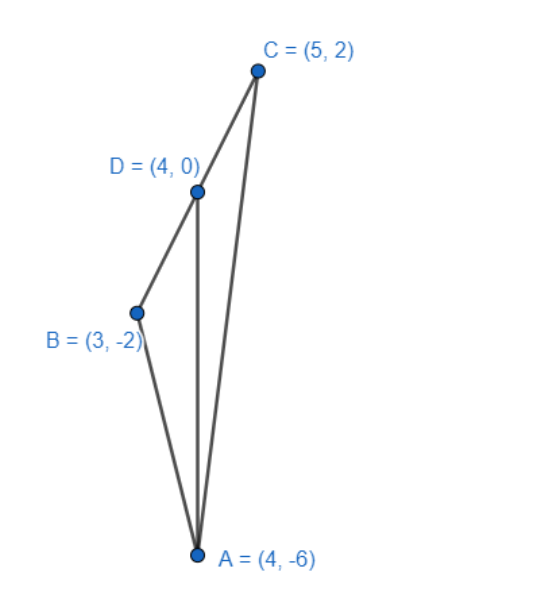Question
Question: Verify that median divides a triangle into two triangles of equal areas for \( \Delta ABC \) whose v...
Verify that median divides a triangle into two triangles of equal areas for ΔABC whose vertices are A(4,−6) , B(3,−2) , C(5,2) .
Solution
Hint : We first take the vertices of ΔABC and try to find the median AD where D is the midpoint of BC. Then we take the midpoint theorem of (2a+c,2b+d) for finding D. after that we find the area of the divided triangles to find the equality.
Complete step by step solution:
We have ΔABC whose vertices are
A(4,−6) , B(3,−2) , C(5,2) .
We know that for given coordinates of vertices of
(a,b);(c,d);(e,f) , the area of the triangle made out of those vertices will be
21∣a(d−f)+c(f−b)+e(b−d)∣ square unit.
We assume that for ΔABC , the median is AD where D is the midpoint of BC.
We know that for given coordinates of vertices of (a,b);(c,d) , the midpoint will be (2a+c,2b+d).
We find the coordinates of D. So, following the mid-point theorem for B(3,−2) , C(5,2) , we get
D≡(23+5,2−2+2)≡(4,0).

Now we find the areas for ΔABD and ΔACD .
For ΔABD , the vertices are A(4,−6) , B(3,−2) , D(4,0) .
Therefore, the area is 21∣4(−2)+3(0+6)+4(−6+2)∣=26=3 square units.
For ΔACD , the vertices are A(4,−6) , C(5,2) , D(4,0) .
Therefore, the area is 21∣4(2)+5(0+6)+4(−6−2)∣=26=3 square units.
We can see that ar(ΔABD)=ar(ΔACD)=3.
Thus, Verified that the median divides a triangle into two triangles of equal areas.
Note : Instead of taking AD, we could also have taken the medians like BE and CF. The final claim of getting triangles of equal areas remains the same for all medians.
